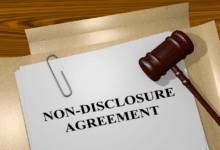What is an NDA?
Although NDA’s and confidentiality agreements are not required by law, they are a common way for companies to protect their trade secrets. A “confidential relationship” is established when two people enter into an NDA or a confidentiality agreement. One or both parties must keep the information secret under this type of connection.
Non-disclosure agreements, sometimes known as confidentiality agreements, non-disclosure contracts, and confidentiality disclosure contracts, are one type of agreement. You may come across one at the start of a business relationship or a large financial transaction. An employer or client, for example, might request that a new employee or contractor sign a non-disclosure agreement
An NDA is a business contract that covers individuals’ or organizations’ information privacy, which differs from other service or sales contracts in that it focuses on the terms and conditions of service rather than transactions.
The purpose of a Non-Disclosure Agreement
A non-disclosure agreement (NDAs) is designed to provide both confidentiality and protection. Everything from product specifications to client lists is covered by a non-disclosure agreement. An NDA may contain anything from business models to test data to embargoed news releases or product reviews.
An NDA is a legal contract that protects ideas and information from being stolen or shared with competitors or third parties. Breaking an NDA agreement has serious legal consequences, including fines, litigation, and even criminal penalties. NDAs offer your business a level of security that goes above and beyond what the law requires.
There are three key roles of an NDA:
- Identifying sensitive information: NDAs distinguish data by drawing a line between what is confidential and what can be shared. This enables the parties to work in peace within the confines of the confidentiality agreement.
- Signing an NDA creates a legal duty to keep sensitive information private. Any disclosure of that information is a breach of contract.
- Keeping Patents Secure: An NDA can protect an inventor while they develop their new product or concept by protecting his or her patent rights from being jeopardized by public disclosure of the invention.
When do I need an NDA?
Sensitive information must sometimes be given to strangers or third parties when trying to raise cash, hire new staff, seek new partners or collaborators, and so on. NDAs safeguard a firm against any potential hazards during these operations.
When do you need an NDA? The following are five situations that may necessitate the use of an NDA.
- Products: When your company sells or licenses a product or technology, you must make sure that any technical, financial, or other proprietary data you offer can’t be shared with third parties.
- Employees: Because of their access to sensitive data, you must ensure that your workers cannot pass on your company’s confidential and proprietary information while they are at work or once they have left.
- Partners: You must protect the information you convey during negotiations with a new partner or investor.
- New Clients: When onboarding a new client, your company may come across that firm’s confidential information. An NDA can safeguard your business by ensuring that no sensitive data is accidentally shared, avoiding legal exposure.
- Mergers and Acquisitions: When selling a firm, sensitive financial and operation information must be shared with not just the entity buying your company, but also with intermediaries and brokers. An NDA protects data.
Confidentiality agreements are also typical when disclosing information to possible investors, engaging providers, or negotiating joint ventures.
Types of NDAs
Non-disclosure agreements are used in a variety of situations, ranging from employment and business transactions to personal relationships. Nondisclosure agreements may be classified as either unilateral or mutual. One person agrees not to reveal confidential information in a unilateral non-disclosure agreement. Both parties agree not to disclose sensitive information in a mutual non-disclosure agreement
When it comes to enforcement and the consequences of a breach, these two sorts of confidentiality agreements are comparable in all other ways.
A unilateral NDA is a good example of an employment contract. When a person is hired, they sign a one-way NDA that states they will not share anything about their job with others. A mutual NDI, on the other hand, ensures that none of the parties participating in the transaction discloses sensitive information.
Here are some questions to consider while drafting your confidentiality agreement:
- Business Type: Is there a back-and-forth exchange of information, or is it the case that many actors are involved (e.g., mergers and acquisitions, joint ventures, teaming agreements)?
- Reciprocity: Is the agreement equally protected and obligated on both sides, so that neither is unjustly ” Favoured” by it?
- Number of Parties: Is there more than one entity involved, or are each of the participants supplying information?
Parts of a Non-Disclosure Agreement
All NDAs should include these specific elements:
- Identification of Parties: The section known as “parties to the agreement” (also known as “nondisclosure contracts”) is used to identify those who are or will be involved in the non-disclosure contract. It identifies both the disclosing party and recipient using names and addresses. Attorneys, accountants, and business partners may be included among relevant parties.
- Definitions: This portion of the NDA details the many sorts of information covered by the agreement, as well as governing procedures for how it is handled. It addresses the question of what information should be kept secret.
- Obligations: What are the ramifications if protected information is shared? An NDA not only specifies each signatory’s obligations and rules, but it also describes the penalties for failing to meet those requirements.
- Scope: A clear scope makes an NDA enforceable. Using broad phrases like “proprietary information” isn’t precise enough and won’t survive a court case. The NDA’s scope should describe exactly what information is covered.
- Time frame: NDAs don’t always last for a long time, and confidentiality agreements usually state how long sensitive information should be kept quiet. Even those with an infinite duration will usually indicate when the agreement is no longer valid.
- Return of Information: An NDA might stipulate that the recipient confirm that sensitive information has been returned or destroyed after the conclusion of trade between the parties.
- Exclusions: These are the types of information that don’t have to be treated as private. This might cover known facts, previously given information, or knowledge someone acquired before entering into a business or financial relationship with a company or firm.
- Remedies: What happens if there’s a breach of the confidentiality agreement? There are numerous possibilities for action or remedies. Restraining orders, compensation for damages, and other actions for breaches of fiduciary duty and copyright, patent, or trademark infringement are all possible outcomes.
Limitations of NDAs
However, not all information is safeguarded by a non-disclosure agreement. Non-disclosure contracts do not apply to public records, such as SEC filings or company addresses.
The courts may broaden or narrow the meaning of an NDA in ways that participants might not have anticipated. If sensitive information covered by an NDA is disclosed in another manner, such as during a court session or subpoena, the agreement no longer applies.
Also, managing numerous NDAs as a company soon becomes unsustainable without standardized language. When the number of NDAs rises to hundreds, reviewing, bargaining, and concluding unique contracts manually becomes time-consuming and difficult. A standard confidentiality agreement may help mitigate this problem if the organization takes the time to draft a customized NDA that meets all of its requirements.
Signing an NDA
There are several circumstances in which you may be asked to sign an NDA, such as:
- Starting a new position with an employer
- Getting started on a new project with a new customer
- Investing in a new business area
- Discussing a business collaboration or joint venture
- Merging or acquiring a firm
It’s common to be asked to sign a non-disclosure agreement when you’re given access to sensitive information, as well as any other time you’ll be given access to such data. It’s critical to understand what to search for in an NDA when that happens.
Expect to see clauses concerning mutual non-disclosure and non-solicitation, as well as provisions stating the jurisdiction where disputes will be handled.
Take time to read the NDA carefully and make sure you understand it before signing. If you encounter broad or ill-defined language that limits your rights, it may be worth refusing to sign until it is changed. Specific examples of this may include limitations on things such as public knowledge, the knowledge that you already have, and information received from a third party
Creating an NDA
A non-disclosure agreement (NDA) is an important legal document that you can use to protect sensitive information from being stolen or leaked. If you’re new to the recruiting business or are discussing sensitive issues with a possible investor, an NDA may be useful. NDAs are popular among big businesses like Mastercard to safeguard client confidentiality:
To create a legally-binding non-disclosure agreement, you must use precise wording when defining confidential information, parties, and scope.
The vague language that may apply to many situations might not survive a legal challenge. Also, NDA creators must be cautious about disclosing critical data before the agreement is signed in order for the contract to be effective.
There is currently no accepted method for NDAs, leaving businesses to create their own. This puts a significant strain on legal departments, who may be distracted by other matters. A standard NDA helps ease this burden; in an ideal world, the contract is automated, signed with the click of a button, and stored and updated electronically in case you need it.
A non-disclosure agreement does not need to be signed by a lawyer. If the information you wish to keep under wraps is critical enough to necessitate an NDA, you might want to seek legal counsel on it. This software also assists with tracking and managing NDAs on a corporate level, as well as providing a framework for doing so.
- To your advantage, be mentally and ethically focused. The non-disclosure agreement should just include commitments to keep information private. Provisions such as non-solicitation and non-competes are likely to elicit a response from the signing party.
- In general, NDAs are short. An NDA should ideally be on one page. Use simple and direct language that solely focuses on the facts of the situation.
- Templates should only be used after you’ve carefully considered their pros and drawbacks. NDA templates that apply to the organization as a whole are useful, but every scenario is different. Check the confidentiality agreement to make sure the definitions, access, and safeguards it covers are appropriate for your use case.
- Learn your terminology. It’s not always necessary to include provisions regarding severability, change in control, or damage limitation. Other times, they may need further explanation.
Consider using contract lifecycle management software backed by legal experts to help you write an NDA on your own. These programs include digital contract management systems that keep, track, arrange, and collect signatures on contracts. You’ll have everything you need with a workflow designer, data repository, and collaboration tools to automate contract operations like keeping track of expiration dates and
Next steps
Are you ready to upgrade your contract management? FJ Solicitors can help you automate away your NDAs. To be one step closer to drafting your first non-disclosure agreement, fill out a consultation form here.
Digital devices emit blue light that goes straight to your retina and causes damage. Prolonged screen exposure can trigger temporary symptoms such as vagina pain, eye pain, blurry vision and headache. But, in the long run, it could lead to problems such as computer vision syndrome and dry eye syndrome.


